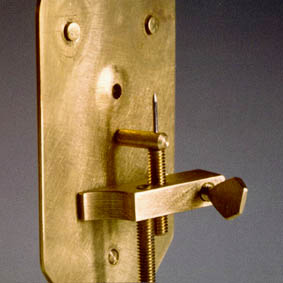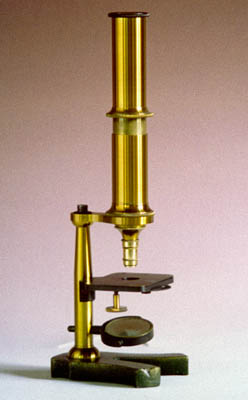|
The History of the microscope |
An introduction to Microscopy |
|
|
It is not quite certain who invented the microscope. Probably, spectacle makers in Middelburg, The Netherlands, invented both the compound microscope and the refracting telescope, between 1590 and 1610. The names most mentioned are those of Hans and Zacharias Janssen. The first well known users were van Leeuwenhoek and Hooke. Van Leeuwenhoek used a single lens microscope, Hooke used a compound microscope. The instruments used by Van Leeuwenhoek were far superior to those of Hooke, due to the fact that lens corrections were unknown at the time and the compound microscopes used by Hooke added the lens faults of ocular and objective. So it was Van Leeuwenhoek who made the most discoveries, also due to his sharp eyesight and his unfailing curiosity. The close up image shows the simplicity of a Van Leeuwenhoek microscope. A subject was placed on the needle and could be positioned with the adjusting screw. |
a Van leeuwenhoek microscope |
| In the end, the compound microscope however had the future. Although instrument makers like Culpeper, Cuff among others, made beautiful instruments, the real improvement of the microscope came with the invention of the achromatic lens. Achromatic lenses for spectacles were developed by Chester Moore Hall, since 1729. But it was difficult to make small high power achromatic lenses. Jan and Harmanus van Deyl were the first to make these lenses, at the end of the eigteenth century and Harmanus van Deyl started the commercial fabrication of achromatic objectives in 1807. They built on the work of Lister. The lenses with the highest numerical apertures were produced round 1900. | |
|
a simple compound microscope
|
A famous producer of top quality microscopes was the firm of Powell and Lealand. Hugh Powell made very high power objectives, an apochromat immersion lens of NA 1,50 in 1896 for instance. Other producers were Ross and Smith and Beck, Nachet, Amici and many other famous names. Carl Zeiss Jena produced its first oil immersion objective in 1880, designed by Ernst Abbe, who was the founder of the optical theory of microscope lenses. Due to better mass fabrication techniques, microscope fabrication was concentrated in Germany after the beginning of the twentieth century. Further developments followed; improvement of the microscope stand and more important even, the development of methods to increase the contrast. The Dutchman Zernike invented the phase contrast microscope in 1934. Other contrast enhancing methods were developed, modulation contrast devised by Hoffman and Gross and differential interference contrast (DIC) , all with several variants. A well known DIC sytem was patented by Nomarsky in 1953. And fluorescence microscopy, in principle already seen by Köhler in 1904, has become a very valuable addition to light microscopy since about 1970. |
| This very short and incomplete sketch will of course point to the use of electronic means of imaging, enhancing and influencing contrast and giving enormous possibilities for the next century in the further development of the microscope. | |
|
Please note: this is a free resource provided by Microscopy-UK. We have worked for 7 years without pay to create one of the most content-rich sites on the web. Our costs are increasing. If you believe this resource is worth keeping freely available to all, perhaps you might wish to consider donating just a small amount to help? Please click here if you might like
to consider a small donation.
The following links will lead you to a variety historic microscopes as well as modern types. |

